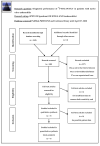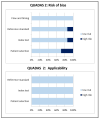Diagnostic Performance of 18F-FDG PET/CT in Native Valve Endocarditis: Systematic Review and Bivariate Meta-Analysis
- PMID: 32993032
- PMCID: PMC7601576
- DOI: 10.3390/diagnostics10100754
Diagnostic Performance of 18F-FDG PET/CT in Native Valve Endocarditis: Systematic Review and Bivariate Meta-Analysis
Abstract
Background: Infectious endocarditis is a life-threatening disease, requiring prompt and accurate diagnosis. The aim of this article is to perform a systematic review and meta-analysis of the literature to estimate the performance of fluorine-18 fluorodeoxyglucose positron emission tomography/computed tomography (18F-FDG PET/CT) for the diagnosis of native valve endocarditis (NVE).
Methods: Selected articles evaluating the diagnostic accuracy of 18F-FDG PET/CT in patients with suspected NVE, resulting from a comprehensive literature search through the PubMed/MEDLINE and Cochrane library databases until April 2020, were included for the systematic review and meta-analysis.
Results: Seven studies (351 episodes of suspected NVE) were included. 18F-FDG PET/CT yielded a pooled sensitivity of 36.3% and a pooled specificity of 99.1% for the diagnosis of NVE. The pooled positive likelihood ratio, negative likelihood ratio, and diagnostic odds ratio were 8.3, 0.6, and 15.3, respectively. The sensitivity increased using contemporary PET/CT device with state-of-the-art patient preparation as well as innovative image acquisitions or adding the results of 18F-FDG PET/CT in a multimodality strategy.
Conclusions: In our systematic review and meta-analysis, 18F-FDG PET/CT yielded a poor pooled sensitivity with an otherwise excellent pooled specificity for the diagnosis of NVE; however, several factors may increase the sensitivity without affecting the specificity and these factors should be better evaluated in future studies.
Keywords: 18F-FDG; PET/CT; diagnostic performance; infectious diseases; infectious endocarditis; meta-analysis; native valve endocarditis; positron emission tomography; systematic review..
Conflict of interest statement
The authors declare no conflict of interest.
Figures





Comment in
-
FDG PET in infective endocarditis: There are still horizons to conquer.J Nucl Cardiol. 2022 Oct;29(5):2129-2131. doi: 10.1007/s12350-021-02756-x. Epub 2021 Aug 12. J Nucl Cardiol. 2022. PMID: 34386863 No abstract available.
References
-
- Bin Abdulhak A.A., Baddour L.M., Erwin P.J., Hoen B., Chu V.H., Mensah G.A., Tleyjeh I.M. Global and regional burden of infective endocarditis, 19902–010: A systematic review of the literature. Glob. Heart. 2014;9:1311–1343. - PubMed
-
- Habib G., Erba P.A., Iung B., Donal E., Cosyns B., Laroche C., Popescu B.A., Prendergast B., Tornos P., Sadeghpour A., et al. Clinical presentation, aetiology and outcome of infective endocarditis. Results of the ESC-EORP EURO-ENDO (European infective endocarditis) registry: A prospective cohort study. Eur. Heart J. 2019;40:32223–32232. doi: 10.1093/eurheartj/ehz620. - DOI - PubMed
-
- Murdoch D.R., Corey G.R., Hoen B., Miro J.M., Fowler V.G., Jr., Bayer A.S., Karchmer A.W., Olaison L., Pappas P.A., Moreillon P., et al. Clinical presentation, etiology, and outcome of infective endocarditis in the 21st century: The International Collaboration on Endocarditis-Prospective Cohort Study. Arch. Intern. Med. 2009;169:4634–4673. doi: 10.1001/archinternmed.2008.603. - DOI - PMC - PubMed
LinkOut - more resources
Full Text Sources
Miscellaneous

